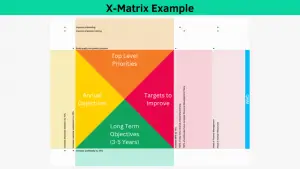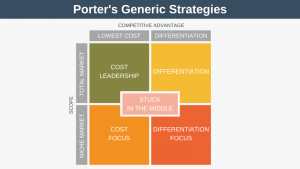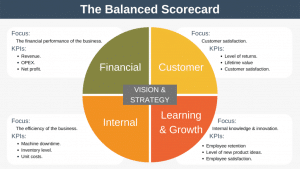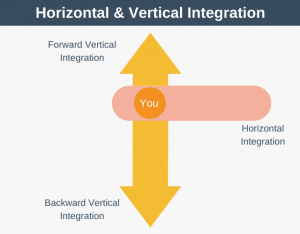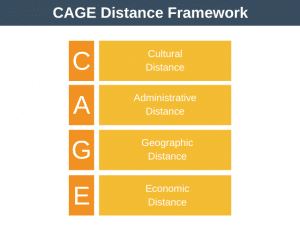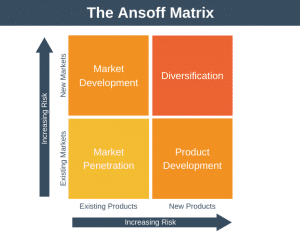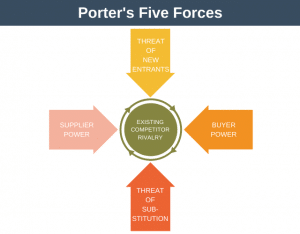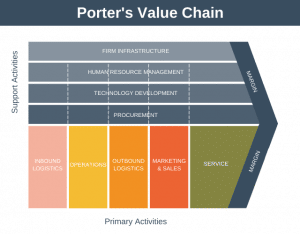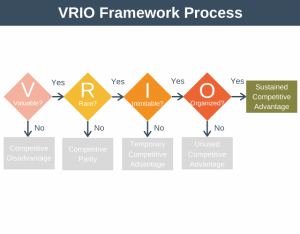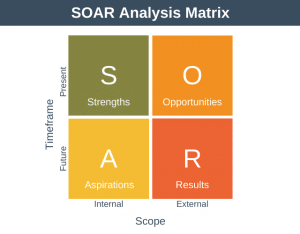The diffusion of innovation theory, created by Everett Rogers in 1962, is a model that explains how, why, and at what rate new ideas and technology spread.
The theory states that new innovative products spread into a marketplace via a wave of acceptance from one group of people to another.
Why is the diffusion of innovation curve useful? Because it can help you accelerate the adoption of your innovation by understanding the best way to market your innovation given where it currently sits on the diffusion curve.
What is Innovation?
Innovation is an idea, practice, or object that is perceived as new by those who adopt it. Innovation is often also viewed as the application of better solutions that meet existing market needs, new needs, or unarticulated needs.
Innovation can be very broad in definition. It could be a change in behavior in society, be a new process, or a new and improved product or service.
Note that an innovative product brings change only when there are enough people ready to adopt it. A product is essentially useless if nobody uses it. The success or failure of an innovation, depends on getting that innovation used by the right people at the right time.
The Diffusion of Innovation Theory?
You can think of diffusion as the process of how the marketplace adopts an innovation.
Diffusion depends on several elements; the nature of the innovation itself, communication, time, and a social system. Without all of these elements present, the innovation will not spread.
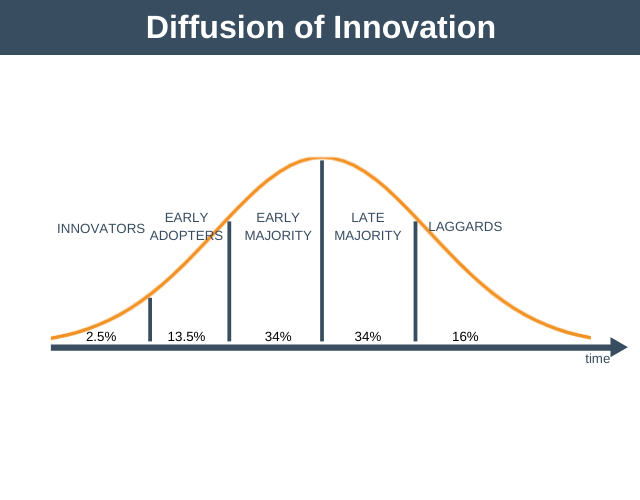
When you create an innovation, no matter how great it is, not everyone will be ready to adopt it.
The diffusion of innovation theory shows the distributions of how different groups across the population (or total addressable market) adopt an innovation.
According to the theory, some people will be more ready to adopt a new innovation than others. The first people to adopt an innovation are called innovators. Innovators represent a total of just 2.5% of the marketplace for your innovation. These are people who embrace new ideas and don’t mind if it isn’t perfect yet.
The last people to adopt an innovation are the laggards.
Why is the theory important? Because by understanding where your product or service is on the curve right now, and by working with that segment, you can accelerate the diffusion of your innovation.
Let’s examine each group in turn.
1. Innovators
Innovators like to embrace and try out new ideas. They are the kind of person who is first in line to try a new product, even if it’s not perfect.
Because innovators don’t mind if a product isn’t perfect they represent an ideal group to test your ideas and prototypes with.
Although innovators make great testers they don’t tend to have much of a social following and so are not great at encouraging others to try your innovation. This is where early adopters come in.
2. Early Adopters
Early adopters are opinion leaders and influencers. They enjoy sharing their views and opinions with others, who tend to look to them for advice and guidance.
They might like the idea of a new product, but don’t want to be the very first people to try it out. They are not quite as ready to try a new idea as innovators. By giving them good reasons to adopt a new product and demonstrating how it works, they will use it. They will then let their followers know what they think about it.
3. Early Majority
The early majority are followers. They don’t like to take undue risks or try out brand new ideas.
Compared to innovators and early adopters they are slow to adopt new innovations as they take longer to deliberate before trying something out.
They rely on proof from others, typically the early adopters whose opinion they value, before deciding it is okay to adopt or trail an innovation.
Early adopters will try something out just before the average member of a social system.
4. Late Majority
The late majority approach innovation with a degree of skepticism. They will try something just after the average member of a social system.
Whilst they are curious about innovation they will not adopt it until most of their social system has already adopted it. They need to be persuaded by others as to the value of innovation.
5. Laggards
This final group lag behind trends and do not like innovation or change. They are unlikely to find out about innovations, are conservative, and bound by tradition. As a result, they are the hardest group to influence. They join only when they have to.
Laggards have no opinion leadership, and when they do adopt an innovation it may already be obsolete by new innovations being used by innovators.
The Tipping Point
An important point to understand about innovation diffusion is the tipping point.
This is the point at which a small change in adoption is enough to cause a larger more substantial change.
You can think of the tipping point as the point at which adoption catches fire, and adoption of the innovation happens at an exponential rate through the population.
The tipping point happens when the early majority begin to adopt an innovation en masse.
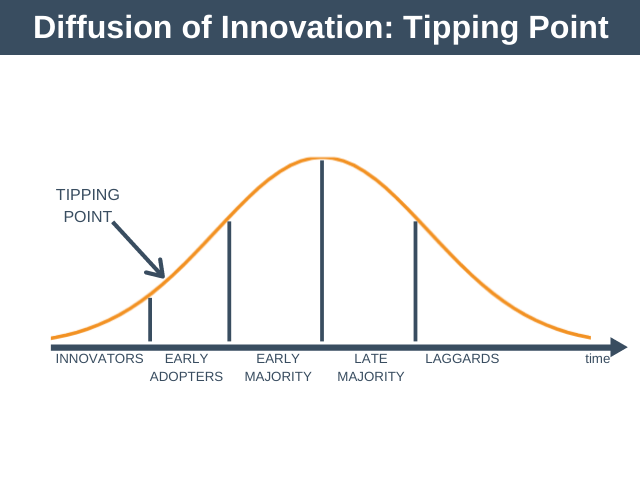
Attributes of Innovation
People do not automatically adopt new products and innovations. They must have a reason to do so.
The diffusion of innovation theory provides five reasons why an individual might choose to adopt a product.
- Relative advantage: The new product is perceived as more useful than existing products.
- Compatibility: The new product is perceived as compatible with their lifestyle. Successful innovations are easy to adopt, they don’t require a huge change in how things are done or the purchase of additional products to make them work.
- Complexity: The more difficult it is to learn how to use a product the greater the barrier to adoption.
- Trialability: Can the product be tried out before it is adopted? Allowing people to explore your innovation before they purchase lowers the barrier to innovation.
- Observability: Are there tangible results that can be measured by adopting the product? The better the results from the innovation they lower the barrier to adoption.
Diffusion of Innovation Examples
Let’s take a look at using the model to work out how to improve the adoption of a product.
Improving the adoption of a product is different for every business and every product. Because each and every situation is unique, you have to do what is right for you.
Let’s take a look at two examples; one for a new startup and one for a mature product.
Example 1: New Startup + New Product
Imagine you run a startup that is launching an innovative smartwatch. You have done some market testing with innovators, and are very confident in your product, and want to increase sales and maximize adoption.
The adoption curve shows you need to begin to engage with early adopters. The idea is to maximize adoption in this group and encourage them to tell others about the smartwatch.
Early adopters tend to be social, have money, and have connections. A plan to get them using the product might include:
- Reaching out directly to influential influencers and asking them to try your product.
- Clearly communicating how the smartwatch has all the attributes of innovation.
- Paying for early adopters to trial the product and asking for product reviews to be shared with their audience.
- Inviting innovators to a launch event.
- Advertising on media channels that early adopters inhabit, such as blogs.
Now you have a plan you can engage with early adopters with the ultimate aim of reaching the tipping point of adoption.
Example: Mature Company + Product Evolution
Imagine Microsoft wants to launch a new version of the Surface laptop.
This new version of the product will cost more to purchase than the existing version, but it will also contain new features and improved performance.
Because of this Microsoft could choose to adopt a two-pronged approach.
- Continue to push the existing Surface laptop to later adopters and laggards. This push could be enhanced by offering a 30-day free trial and by reducing the price of the current model.
- Soft launch the new model, offering them free to early adopters, with the aim of building up huge demand amongst the remaining early adopters and early majority when the product is finally released publically. When the soft launch is concluded, conduct a big launch at scale accompanied by adverts across all media channels.
Advantages and Disadvantages
There are a number of advantages and disadvantages associated with the diffusion of innovation theory.
Advantages
- The theory is well established and is based on thousands of examples, so it can be considered to be somewhat reliable.
- The theory can inform product marketing. Each adopter group can be targeted with specific communications that build trust and accelerate the adoption of a product.
Disadvantages
- It can be challenging to determine the actual reasons for the adoption of an innovative product because social systems are very complex.
- The innovators and early adopters typically account for just 16% of the potential adoption population. Relatively, this is a small cohort to rely upon to gain the exposure needed for a product to take off.
Summary
The diffusion of innovations theory is a model that explains how, why, and at what rate new ideas and technology spread.
The theory characterizes five different groups of adopters. A product spreads into a marketplace via acceptance from one group to the next.
The theory can be used to help organizations speed up the rate of adoption by working closely with the product’s current segment.
